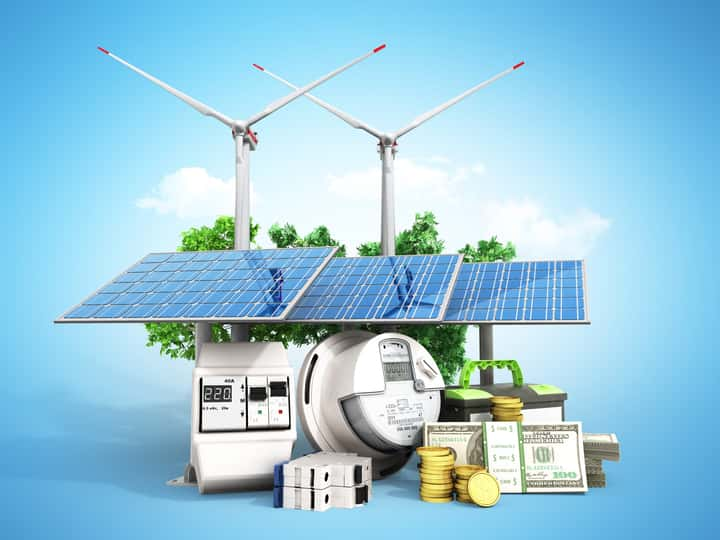-
US policy supports alternative energy sources
-
The sun is a massive energy producer
-
A diversified investing approach mitigates idiosyncratic risks
-
The Invesco Solar ETF holds shares of leaders in the solar power sector
-
A diversified product that has corrected to a level that is in the buy zone for the future
The stock market continues to rise to new heights almost daily. The leading indices have been changing places when it comes to the trajectory of the bull market. In 2020, the tech-heavy NASDAQ led the way with an over 40% gain for last year. In 2021, the S&P 500, Dow Jones Industrial Average, and Russell 2000 have been vying for a leadership role as the top position changes places.
In late 2020, energy-related stocks took over leadership roles as sector rotation took traditional oil and gas companies’ shares higher after lagging the overall market since 2018. Meanwhile, alternative energy companies reached peaks in 2008 when crude oil’s price moved to its all-time high at $147.27 per barrel. After reaching lows in March 2020, the alternative energy sector has been rallying. The change in US administrations after the November 2020 election pushed alternative energy company stocks to the highest levels since 2008. The Invesco Solar ETF product (TAN) holds shares in companies that harness the sun’s energy to power the world.
US policy supports alternative energy sources
The drill-baby-drill and frack-baby-frack era under the Trump administration ended on January 20, 2021. On his first day in office, President Biden canceled the Keystone XL pipeline project in a symbolic move. The pipeline carried petroleum from the oil sands in Alberta, Canada, to Steele City, Nebraska, and beyond to Cushing, Oklahoma, the delivery point for NYMEX crude oil futures.
Addressing climate change via supporting alternative power sources and inhibiting hydrocarbon production and consumption is the new direction of US energy policy. Meanwhile, increased regulations are coming as energy demand is rising. As vaccines create herd immunity to COVID, life is returning to what is likely a new normal. People will return to the workplace and take long overdue vacations over the coming weeks and months. Energy demand is rising, and we have seen oil and gas prices rebound. Crude oil traded to its lowest price since futures began trading on April 20, 2020. At the end of last week, nearby NYMEX crude oil futures were just above the $63 per barrel level, over $100 above April 2020 low when it traded below negative $40 per barrel.
Natural gas fell to a quarter-of-a-century low of $1.432 per MMBtu in late June 2020. The price has made higher lows over the past months. Even though the peak season for demand has ended, nearby NYMEX natural gas futures were at the $2.68 level as of April 16, nearly $1.25 per MMBtu above the June 2020 bottom.
Oil and gas continue to power the US and the world. Still, the Biden administration’s policies will shift the demand to alternative energy sources as it increases regulations that weigh on hydrocarbon output.
The sun is a massive energy producer
The sun is an incredible power source. Harnessing solar power is an integral part of President Biden’s plans for energy. The earth’s primary source of energy is the sun. The sun’s energy is essential for many earthly processes, including warming of the surface, evaporation, photosynthesis, and atmospheric circulation. Technology continues to enhance our ability to harness the sun’s energy. Photovoltaic cells convert sunlight into electricity. These cells are the critical components of solar panels on increasing roofs across the US and world. Solar thermal technology uses the sun’s heat to make hot water or steam that can create power.
The number of companies converting the sun’s energy into power began rising in the early 2000s. Some of the stocks peaked in 2008 when crude oil’s price reached an all-time high at nearly $150 per barrel. At that time, the cost considerations supported the solar energy business. Today, it is climate change that paves the way for solar power’s future.
A diversified investing approach mitigates idiosyncratic risks
There are many choices for investing in companies that convert the sun’s power into energy. Some companies are fully integrated, solar power producers. At the same time, others are pick-and-shovel plays that produce critical solar power infrastructure, measurement tools, or other essential components for the solar industry. Solar panel manufacturers are an example of a pick-and-shovel business in the solar sector.
Individual companies carry idiosyncratic risks such as management, specific products, government regulations and contracts, and a host of other factors that impact expenses and earnings. A diversified investing approach in the solar sector mitigates some of those risks. The Invesco Solar ETF product (TAN) provides diversified exposure to the solar industry.
The Invesco Solar ETF holds shares of leaders in the solar power sector
TAN’s top holding and fund summary include:
Source: Yahoo Finance
TAN had $3.175 billion in assets under management as of the end of last week. The ETF product trades an average of over 1.85 million shares each day. TAN changes a 0.69% management fee.
Source: Barchart
The chart shows the TAN ETF hit an all-time high at $307.90 per share in May 2008 as crude oil rose to its record peak. 2008 was the last time natural gas prices were above $8 per MMBtu and rose to a high of $13.694 per MMBtu that year.
In 2008, rising energy costs lifted the TAN to its all-time peak. In 2020 and 2021, the US election and shift in US energy policy pushed TAN to $125.98 per share, the highest level since November 2008. Climate change and the shift in US energy away from hydrocarbons are likely to cause a far more sustainable environment for solar companies. The sun is no longer a cost factor but a matter of “survival,” according to many leaders worldwide.
A diversified product that has corrected to a level that is in the buy zone for the future
Since reaching a peak at nearly $126 per share in January 2021, the TAN ETF has pulled back.
Source: Barchart
The chart shows the rise from $21.14 during the height of the risk-off action in markets in March 2020 to $125.98 in January 2021. Since the high, TAN pulled back to the $85.49 level at the end of last week. The over 32% decline could be an opportunity to harness the sun’s power for your portfolio.
The shares of many solar-power and related alternative energy companies may have pulled back. Still, the Biden administration’s plans for addressing climate change via power from the sun, wind, hydro, and other non-hydrocarbon sources are not backing down any time soon. TAN is a product that provides exposure to solar power, which will receive government subsidies and see its business grow over the coming months and years.
Want More Great Investing Ideas?
TAN shares were trading at $83.81 per share on Tuesday morning, up $1.06 (+1.28%). Year-to-date, TAN has declined -18.44%, versus a 11.23% rise in the benchmark S&P 500 index during the same period.
About the Author: Andrew Hecht

Andy spent nearly 35 years on Wall Street and is a sought-after commodity and futures trader, an options expert and analyst. In addition to working with StockNews, he is a top ranked author on Seeking Alpha. Learn more about Andy’s background, along with links to his most recent articles. More...
More Resources for the Stocks in this Article
| Ticker | POWR Rating | Industry Rank | Rank in Industry |
| TAN | Get Rating | Get Rating | Get Rating |





